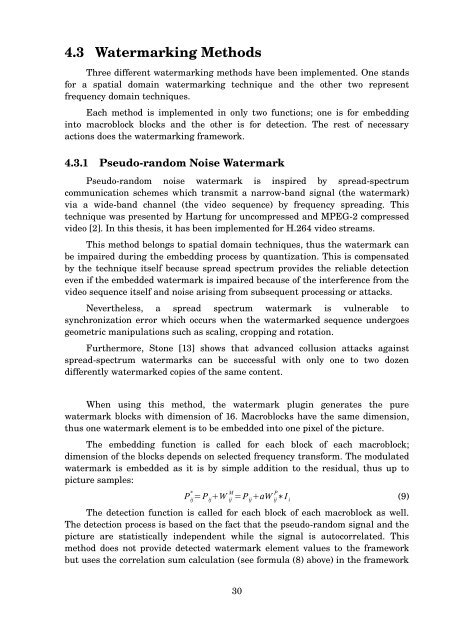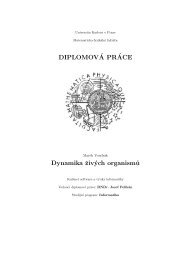MASTER THESIS Video Watermarking - Computer Graphics Group ...
MASTER THESIS Video Watermarking - Computer Graphics Group ...
MASTER THESIS Video Watermarking - Computer Graphics Group ...
You also want an ePaper? Increase the reach of your titles
YUMPU automatically turns print PDFs into web optimized ePapers that Google loves.
4.3 <strong>Watermarking</strong> Methods<br />
Three different watermarking methods have been implemented. One stands<br />
for a spatial domain watermarking technique and the other two represent<br />
frequency domain techniques.<br />
Each method is implemented in only two functions; one is for embedding<br />
into macroblock blocks and the other is for detection. The rest of necessary<br />
actions does the watermarking framework.<br />
4.3.1 Pseudo-random Noise Watermark<br />
Pseudo-random noise watermark is inspired by spread-spectrum<br />
communication schemes which transmit a narrow-band signal (the watermark)<br />
via a wide-band channel (the video sequence) by frequency spreading. This<br />
technique was presented by Hartung for uncompressed and MPEG-2 compressed<br />
video [2]. In this thesis, it has been implemented for H.264 video streams.<br />
This method belongs to spatial domain techniques, thus the watermark can<br />
be impaired during the embedding process by quantization. This is compensated<br />
by the technique itself because spread spectrum provides the reliable detection<br />
even if the embedded watermark is impaired because of the interference from the<br />
video sequence itself and noise arising from subsequent processing or attacks.<br />
Nevertheless, a spread spectrum watermark is vulnerable to<br />
synchronization error which occurs when the watermarked sequence undergoes<br />
geometric manipulations such as scaling, cropping and rotation.<br />
Furthermore, Stone [13] shows that advanced collusion attacks against<br />
spread-spectrum watermarks can be successful with only one to two dozen<br />
differently watermarked copies of the same content.<br />
When using this method, the watermark plugin generates the pure<br />
watermark blocks with dimension of 16. Macroblocks have the same dimension,<br />
thus one watermark element is to be embedded into one pixel of the picture.<br />
The embedding function is called for each block of each macroblock;<br />
dimension of the blocks depends on selected frequency transform. The modulated<br />
watermark is embedded as it is by simple addition to the residual, thus up to<br />
picture samples:<br />
<br />
<br />
<br />
<br />
The detection function is called for each block of each macroblock as well.<br />
The detection process is based on the fact that the pseudo-random signal and the<br />
picture are statistically independent while the signal is autocorrelated. This<br />
method does not provide detected watermark element values to the framework<br />
but uses the correlation sum calculation (see formula (8) above) in the framework<br />
30<br />
(9)
















